Developer Portal
Installation
- Launch Sentinet.msi installation package.
- Read and Accept License Agreement by clicking I Accept.
- Enter User Name, Organization and a valid License Key provided by Nevatech.
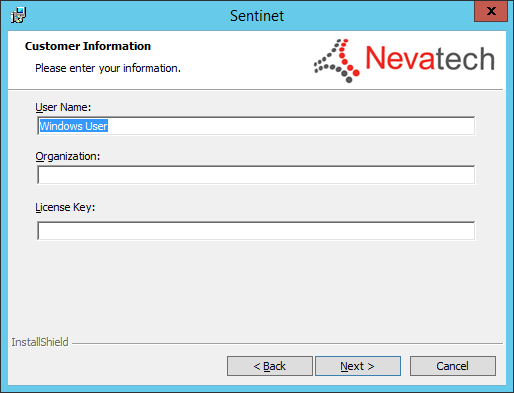
- Select "Custom" to only install Developer Portal. Select Complete for a full install.
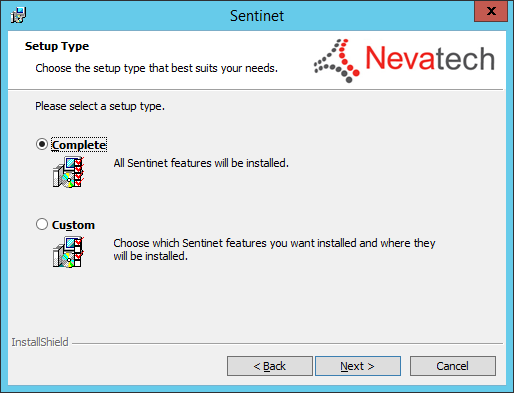
- Select Developer Portal feature if Custom setup type was selected above. Other features are optional.
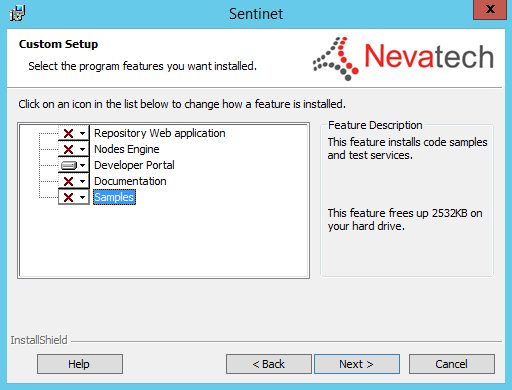
- Click Next to proceed with the installation. Wait for the Wizard to complete the installation.
Configuration
To configure a new or update an existing Developer Portal Web Application:
Start the Developer Portal Configuration application from the Windows shortcut or launch DevPortalConfiguration.exe located in the root of the installation directory. This will open the Developer Portal Configuration Wizard starting with the Repository Database page.
Note
You must be logged in to the machine as a member of the local Administrators group and start the Repository Configuration Wizard with the option “Run as administrator” on the machine with tightened security settings.
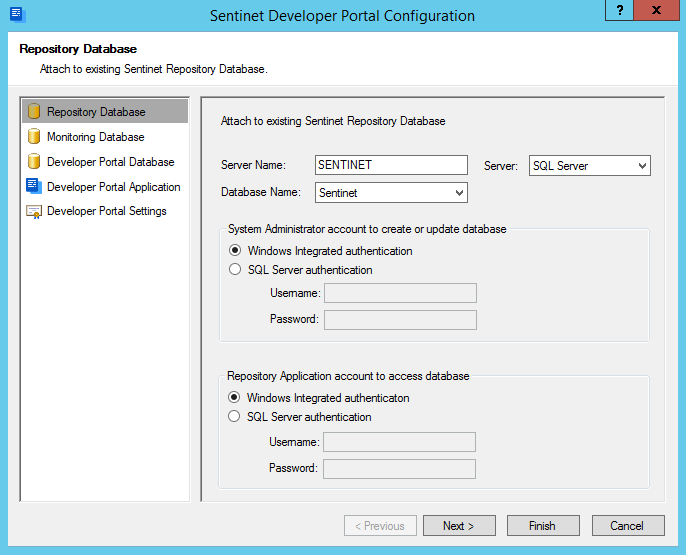
The first page, Database is used to attach to an existing Sentinet Repository database.
- Enter database Server Name where existing Sentinet Repository database resides.
- Select the authentication modes for both the System Administrator and Repository Application accounts (see Configuration chapter for the Repository Web Application in this document).
- Select existing Sentinet Repository database from the Database Name drop-down list. The Configuration Wizard will search for all databases configured on the SQL Server identified by the Server Name field.
Click Next to navigate to the Monitoring Database page.
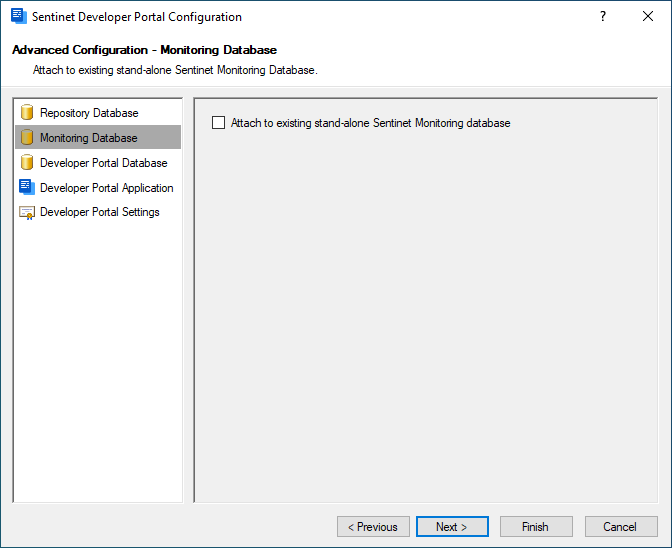
Monitoring Database page provides with advanced Sentinet configuration option when Sentinet Repository Web Application was configured with a stand-alone Monitoring database. Most typical Sentinet deployments do not require this option (Attach to existing stand-alone Sentinet Monitoring database checkmark remains in unchecked state). Details on how to enable Monitoring tables partitioning are described in Appendix G.
Click Next to navigate to the Developer Portal Database page. This page is used to create a new or use an existing Developer Portal CMS database.
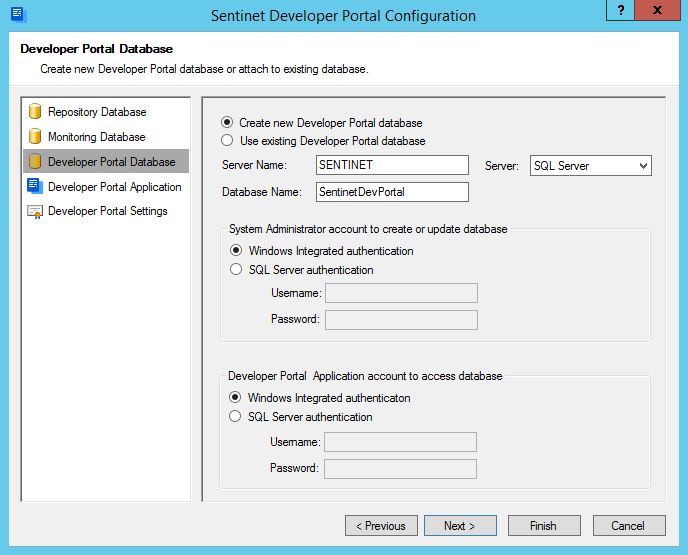
a. Enter database server name or the network address in the Server Name field. When Use existing database option above is selected, the Configuration Wizard will search for all databases configured on the SQL Server identified by the Server Name field. Database Name field will change to a drop-down list of discovered database names. Default server name is the current machine name.
b. Enter database name into the Database Name field. Default database name is SentinetDevPortal.
Note
Developer Portal Configuration Wizard uses default SQL server settings when it creates new SQL server database. If you want to create Developer Portal database with custom settings (e.g. non-default location of the database files), create new empty database with required custom settings using regular SQL server tools. Then run Developer Portal Configuration Wizard and select Use existing database option described in this step.
c. Select the authentication modes for both the System Administrator and Developer Portal Web Application's accounts.
Note
Configuration Wizard uses up to two distinct user accounts to access selected SQL Server instance. Sentinet supports both Windows Integrated and SQL Server authentication. Each account can be selected with its own authentication model. It is recommended to use the Windows Integrated authentication model for both accounts.
System Administrator account is used by the Configuration Wizard to create new or update an existing Developer Portal database. The Configuration Wizard will use the currently logged-in user Windows account if Windows Integrated authentication is selected.
If SQL Server authentication is selected, the SQL Server account must exist and have privileges to create new and update existing databases (for example, sa SQL account).
Developer Portal Application account will be used by the Developer Portal Web Application to get access to the Developer Portal database during runtime.
If an existing SQL database account is selected, then it will be granted the required access to Developer Portal database. If the SQL account does not exist, then it will be created by the Configuration Wizard with the appropriate access privileges.
If Windows Integrated authentication is selected (recommended), then the Windows account (that the Developer Portal Web Application is running under) will be given access to the Repository database. By default, Repository Web Application is created to run under the ApplicationPoolIdentity, built-in machine pseudo-account, which is the standard IIS Server account with the least system access privileges.
Next step explains how to control Developer Portal Web Application’s Windows account.
Create and configure Developer Portal Web Application as an ASP.NET application hosted in IIS Server.
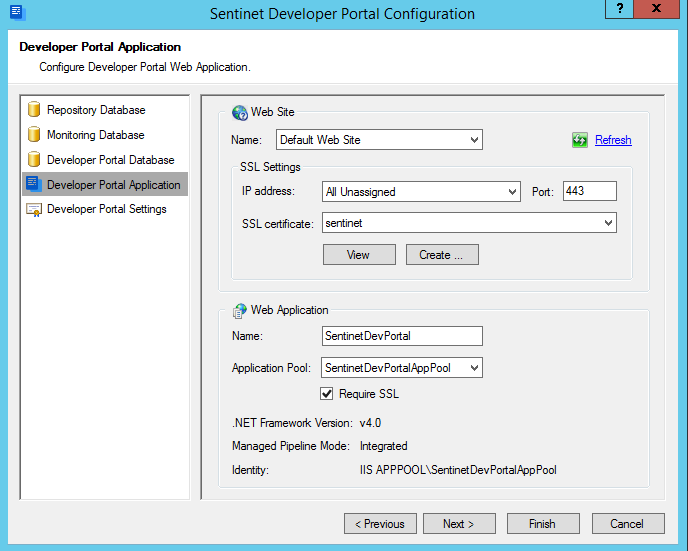
a. Select the IIS Server Web Site that will host Developer Portal Web Application.
b. Select SSL settings.
Configuration Wizard automatically selects SSL settings currently configured with the selected IIS Server Web Site. If the selected IIS Server Web Site is not configured with SSL, you will have to configure it with an SSL port (default is 443), an SSL certificate and optionally, the network cards' listening IP addresses for the Web Site. These are the same settings used by Microsoft IIS Manager to control Web Site SSL configuration. When selecting an SSL certificate, you can choose from the list of the currently installed valid local machine SSL certificates, or request the Configuration Wizard to generate a new self-signed SSL certificate.
To generate a new self-signed SSL certificate, click Create.
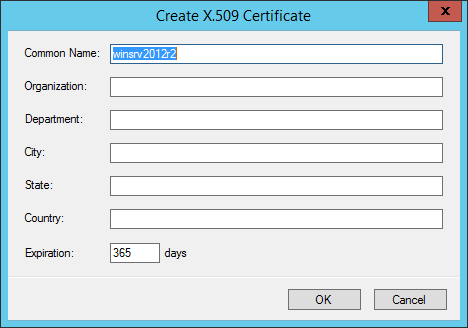
Note
Certificate Common Name and Expiration (in number of days) are mandatory fields. By default, Common Name is the current machine name, and Expiration is set to one year. Pay special attention to the selection of the SSL certificate Common Name, because SSL protocol requires the host address (that client applications will use to access the SSL server) to match the server certificate Common Name. For example, if Developer Portal Web Application will be accessed by Sentinet administrators and by Sentinet Nodes at the www.contoso.com host address, then the SSL certificate must be issued with the Common Name www.contoso.com.
Clicking OK will generate a new self-signed certificate, the dialog box closes and certificate is automatically selected as the SSL certificate in the Developer Portal Application page of the Configuration Wizard.
To review details of selected SSL certificate, click View.
c. Select Web Application settings.
Select the name for the Developer Portal Web Application. The default name is SentinetDevPortal. This will be the name of the IIS Server Virtual Directory and Application. Select the IIS Server Application Pool that will host the Developer Portal Web Application. By default, SentinetDevPortalAppPool is selected as new, isolated IIS Server Application Pool dedicated to Developer Portal Web Application.
Note
You can also select any of the existing IIS Server Applications Pools if the selected pool is configured with .NET CLR Version 4.0 and Integrated Managed Pipeline Mode.
The labels beneath the Application Pool entry field show the properties of the selected Application Pool. The Identity label shows the exact Windows account Identity that is configured with the Application Pool. For example, built-in machine pseudo-account “ApplicationPoolIdentity” shows up as “IIS APPPOOL[Application Pool Name]”.
Developer Portal Application will use the application pool Windows Identity to access the Sentinet Developer Portal CMS database, if Windows Integrated authentication for Developer Portal Application account is selected on the previous Configuration Wizard page.
Selecting different Application Pools allows control of the Developer Portal Web Application Windows Identity. Use the IIS Manager application to create a new Application Pool (or modify the existing) with a desired Windows Identity. Click the Refresh hyper-link on the Configuration Wizard page and select Application Pool created (or modified) by IIS Manager.
Check Require SSL box (recommended by default security settings) to restrict access to Developer Portal Web Application with SSL. Developer Portal Web ASP.NET Application will automatically redirect all traffic to https addresses when Require SSL setting is turned on.
Click Next to navigate to the Developer Portal Settings page.
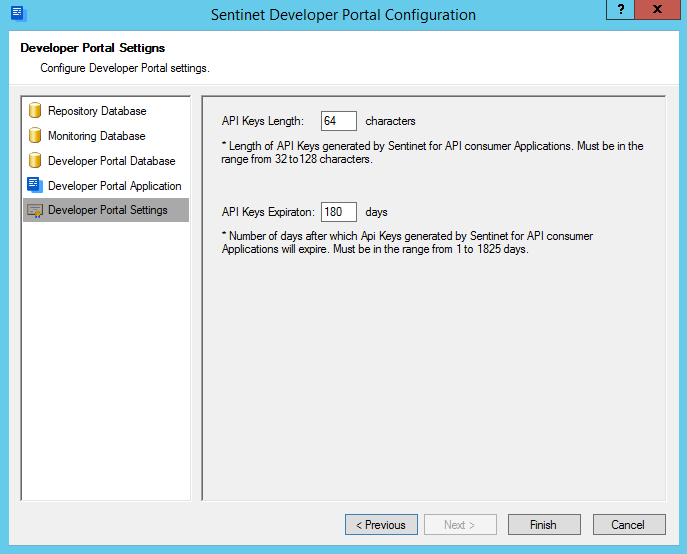
a. Enter the length of API Keys (number of characters) generated by Sentinet for any API Consumer applications that will require API Keys (default is 64 characters).
b. Enter expirations of API Keys (in number of days) generated by Sentinet for any API Consumer applications that will require API Keys.
Click Finish to start the configuration process.
Progress of the configuration process should now be displayed.

Click Close button to close application. If the Launch Application box is checked (default value), a default browser application is started with the home page of the Sentinet Developer Portal.
Note
Before closing Developer Portal Configuration Wizard, you can click Save Configuration button (see screenshot above) to save input data collected by this Wizard in configuration file. This configuration file can later be used for automated deployments, installations and product upgrades (see Appendix A in this document for more details).
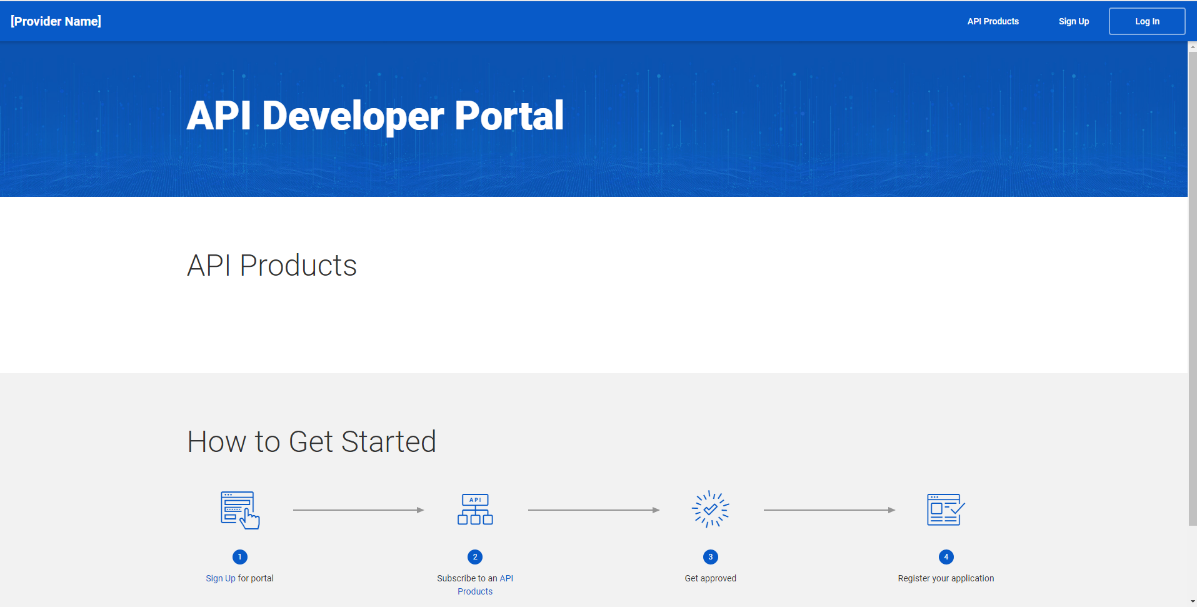
Password Complexity
Be default, Sentinet requires Developer Portal User passwords to be at least 6 characters long with at least one special character. This can be changed in the web.config file of the Developer Portal Web Application.
<appSettings>
…
<!-- The minimum password length. Value must be greater or equal to 6. -->
<add key="minPasswordLength" value="6"/>
<!-- The minimum number of special characters in the password. Value must be greater or equal to 1. -->
<add key="minPasswordSpecialChars" value="1"/>
</appSettings>
Special characters are listed below in quotes and separated by comma:
'!', '@', '#', '$', '%', '^', '&', '*', '(', ')', '[', ']', '{', '}', '|', '=', '+', '-', '_'